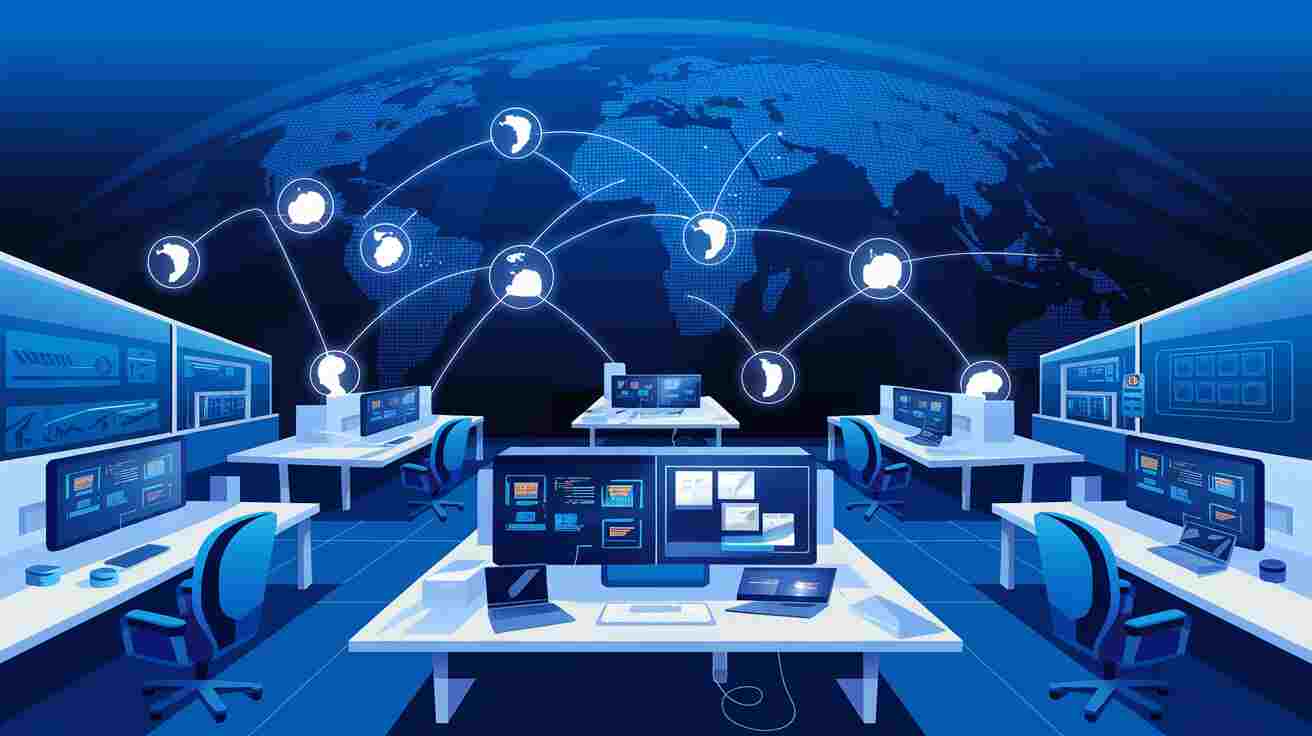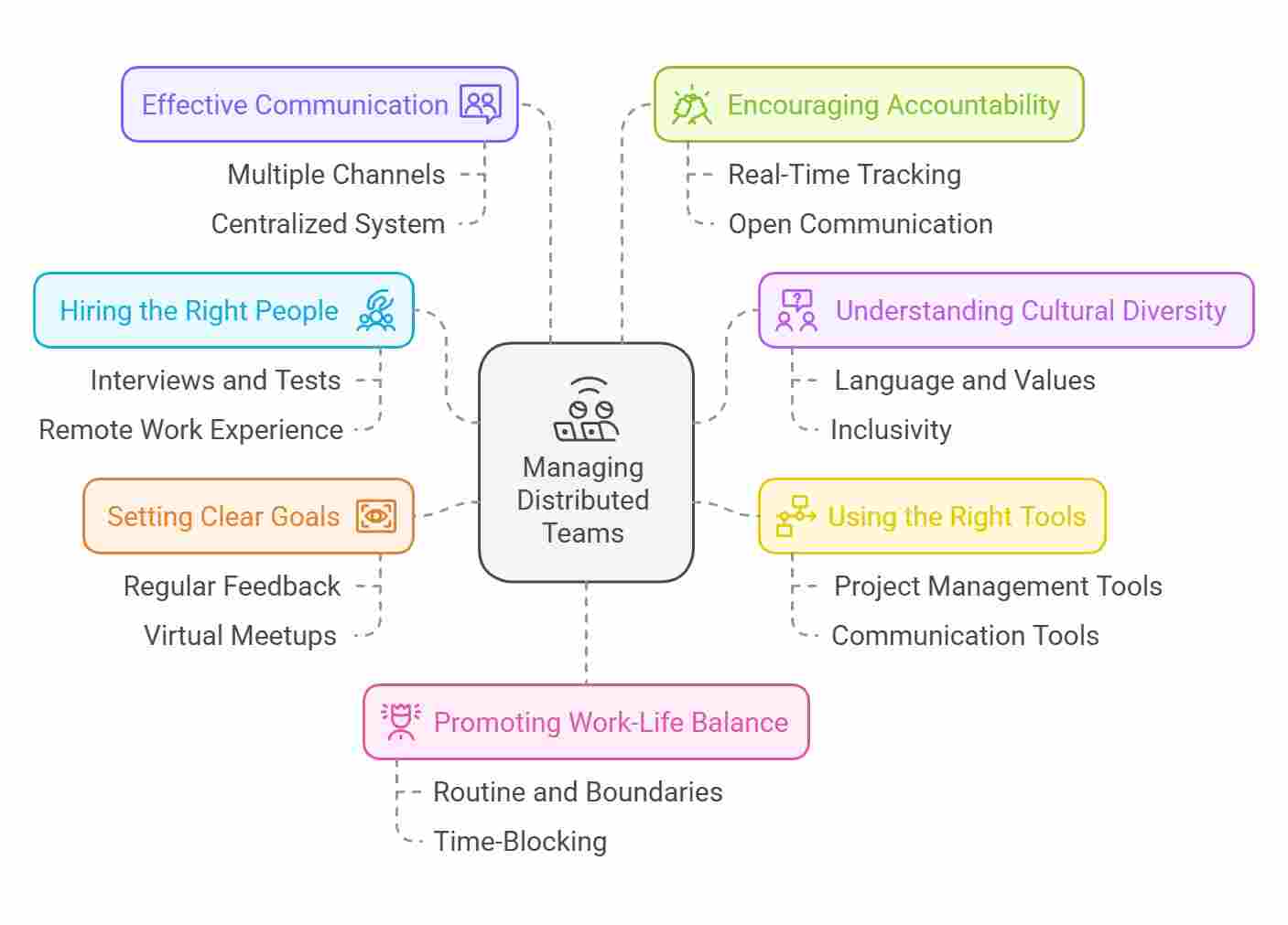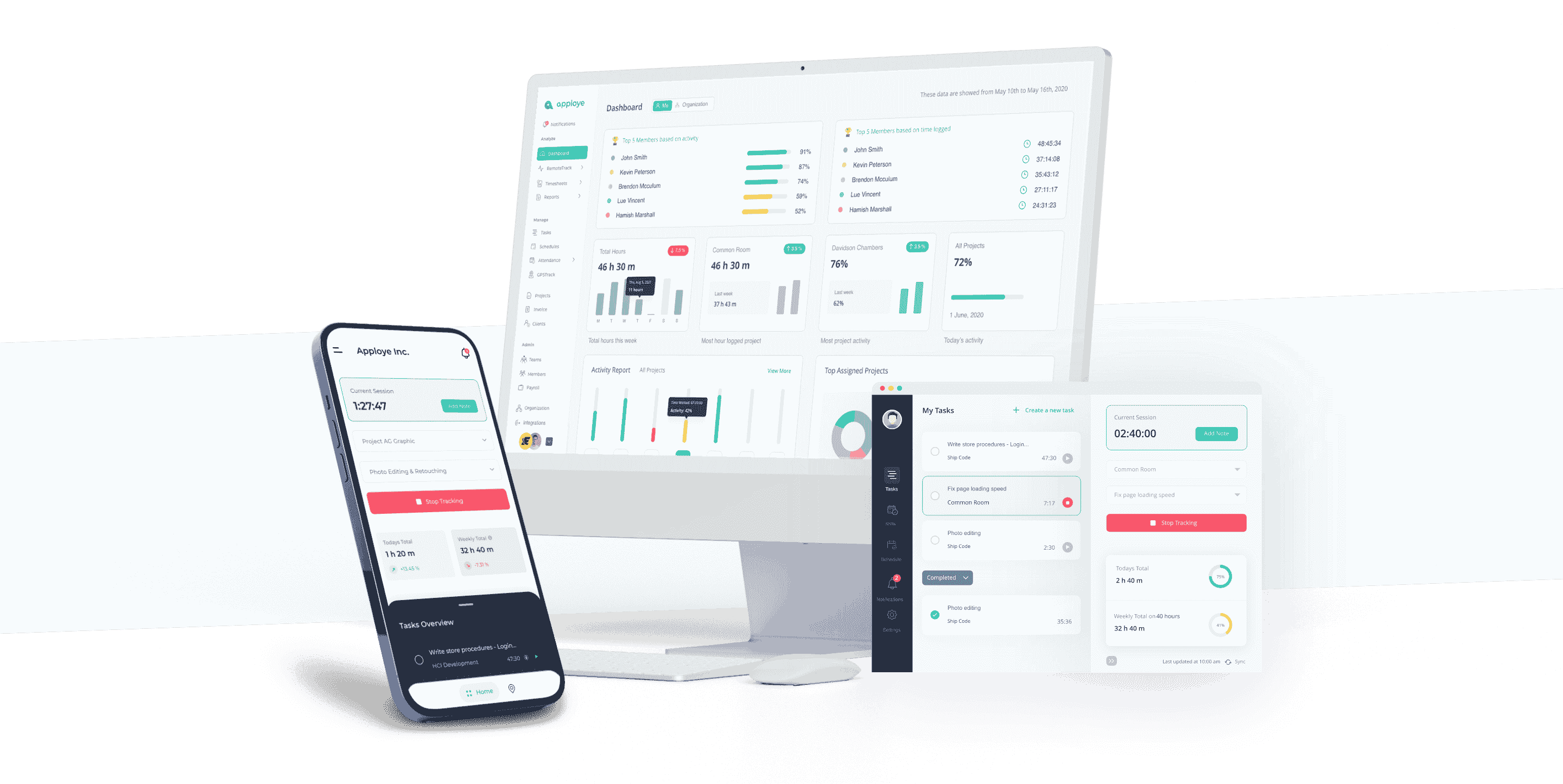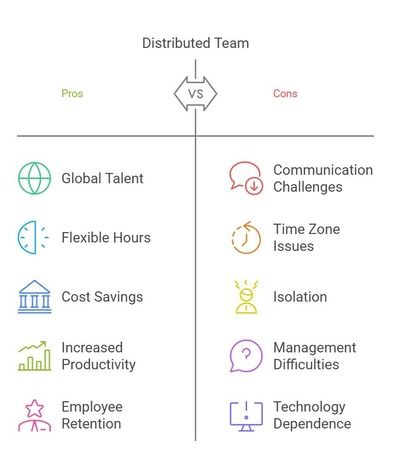Distributed Team Management: What is It and How to Manage!

∎ Distributed teams work from all around the world, giving you access to excellent talent pools.
∎ Solid project management tools are a must to keep track of the process.
∎ Clear goals help everyone stay on the same page and get things done while working remotely.
I first learned about distributed team management when I had a team with members from different countries. There were early-morning meetings with some and late-night check-ins with others.
Besides, I constantly worried about how to keep the team connected.
So you can guess how challenging it is but it also comes with some great opportunities.
In this article, I’ll share those benefits along with:
- What is distributed team management
- Tips for managing distributed team management
- Tools and technologies for distributed team management
- Advantages and challenges
So, let’s get into it.
What is Distributed Team Management?
Distributed team management is leading and coordinating employees working from different locations. It could be across towns or continents.
Take Sarah's marketing team for example - she's in New York, Tom handles social media from London, Maria designs in Barcelona, and Priya writes content from Mumbai. Sarah keeps everyone aligned through daily check-ins, shared project boards, and a team chat channel where they collaborate across time zones.
Despite never meeting in person, they function like a well-functioning machine, hitting deadlines and delivering stellar campaigns together. That's what called perfectly managed distributed teams.
There are two components of distributed team management:
Similar Read: 8 Biggest Project Management Challenges and How to Overcome Them
How to Manage Distributed Teams: Top 7 Tips

Not everyone is suitable for a remote work environment. But the good news is that nearly one-third of U.S. workers who have the option to work from home now choose to do it full-time.
Resumes are not enough when hiring for a distributed team. You must conduct interviews, skill tests, and communication tests to learn more about the candidate.
Ask directly if they are familiar with remote work environments.
It will help you understand how well they might fit within a remote team. When you can hire the right people, your journey becomes a lot smoother.
Look for candidates who are skilled and have experience working remotely. Your team members should be collaborative, have strong, consistent communication skills, and love to share ideas.
2. Understand the Culture of Your Peers
A study by Harvard shows that cultural differences can impact global teams.
In the past, company culture grew from face-to-face and personal interactions. But when you embrace remote work, you need to accept cultural diversity.
Often this culture is shaped by your peers' language, communication, values, and priorities. Culture impacts how teams work, their relationships, and how they deal with customers.
To manage cultural diversity, leaders should focus on key areas like mission, collaboration, and accountability. Clear goals, project scope, open communication, and inclusivity can keep a distributed team connected.
3. Having the Right Tools
When you have a team with different time zones and cultures, managing the team can be difficult. However, having the right tool is a must to manage distributed projects effectively.
Without the right tools, it’s easy to lose track of progress, communication, and deadlines.
Many different tools may help you with different tasks. You must have a good project management tool, a communication tool, a cloud-based tool, and so on. The right tool can make project management processes a lot easier.
These tools can save time, reduce confusion, and deliver projects on time, improving overall productivity.
4. Have a Clear Goal
Leading a team in different time zones and geographical locations is difficult, right? But if you have clear goals, everything becomes easier.
According to Gallup, employees with clear goals are 3.6 times engaged in their work.
When each person knows what’s expected of them, they can manage their work effectively. As long as they meet their deadlines, they can enjoy the freedom of working on their terms.
Once you’ve set the goals, let them decide how to manage their time.
Instead of stressing your employee’s working hours, focus on their work quality. Regular feedback also helps a lot.
Now, how to keep your team motivated?
Since your team isn’t working face-to-face, it’s important to plan virtual meetups. Celebrate small wins and give constructive feedback.
5. Communication
When you work with a distributed team, you can be more flexible than a traditional 9 to 5 job. However, flexibility comes when you can communicate with your team better.
McKinsey's study found that effective communication increases productivity by up to 25%.
I prefer multiple communication channels like Slack for messaging, Zoom for video conferencing, and Apploye for time tracking. Different communication methods work better for different tasks.
Video calls are ideal for personal discussions, while email can be best for a quick head-up. But even if you use multiple platforms, always have a centralized system for final discussion.
Further Read: 17 Best Virtual Team Communication Tools
6. Encourage Accountability
The biggest hurdle in distributed team management is accountability. Everyone is working on their projects, but how to ensure they stay on track?
Accountability starts when you take ownership of actions, decisions, and results. While individuals are responsible for their work, accountability increases, overall building trust among team members.
Employees must be responsible not only for their tasks but also for their group projects. If an expectation can't be fulfilled, it’s important to adjust it quickly or have open communication.
7. Promote Work-Life Balance
Distributed team management offers flexibility, but often we forget the line between personal and professional life.
Many remote employees struggle with balancing responsibilities. 87% of employees will choose flexible work if given the chance.
The first task is to create a good routine to have a good balance between work and life.
Another important thing is to create boundaries when working from home. Encourage your employees not to work after their working hours.
Also, have frequent breaks between work. This way, you won’t feel overworked or bored.
Tools and Technologies for Effective Distributed Team Management
For effective distributed team management, a few tools and technologies can help make the project management processes easier. These are some tools that helped me in the long run:
Cloud-based Technology: Google Drive
Google Drive is a cloud-based storage solution. It allows users to store, create, and collaborate on documents in real-time. It simplifies your file storage, has easy backup features, and integrates with other tools.
You can enjoy some free features that should be enough for day-to-day work. But if you want to upgrade its features, you can buy the paid plans. It offers more storage and other perks.
Features
- Offers 15GB of free storage, shared across Google Drive, G-mail, and Google Photos
- Integrates seamlessly with other Google apps
- You can back up your folders and access your files from any device
Pros
- Easy-to-use interface for storing, syncing, and sharing files.
- Great online collaboration tools for real-time editing.
- Cross-platform apps
Cons
- Privacy concerns, anyone can access your files
Communication Tool: Zoom
Zoom has become a go-to video conferencing tool. The tool became popular during the COVID-19 pandemic.
Zoom is known for its ease of use, extensive features, and outstanding performance.
Zoom helps both individuals and businesses connect virtually. You can communicate, have team meetings, share screens, and record videos.
Features:
- The free version can up to 100 participants
- Record virtual meetings and create transcripts
- Integrates with other tools
- Flexible for both personal and professional use
Pros:
- Unlimited one-on-one and group meetings
- Easy to use
- Hosts up to 100 participants
Cons:
- The mobile version lacks some desktop features
Time Tracking Tool: Apploye

Apploye is a time-tracking and employee-monitoring software. It helps businesses manage their teams more effectively. You can track your employee attendance, working hours, leaves, and project progress all in one place.
The tool offers both manual and automatic time tracking, offering detailed insights to improve productivity. It’s ideal for distributed team management and businesses that want to track time and manage tasks efficiently.
Plus, Apploye is available on both desktop and mobile platforms.
Features
- Automatic time tracking, manual entries, and Pomodoro timer
- Take screenshots and website & app usage tracking.
- Track tasks, assign projects, and monitor budgets.
- Calculates billable hours, manages payments, and generates invoices
- Available on desktop and mobile
Pros
- Easy-to-use interface
- Best for time management
- Affordable pricing options
- Suitable for remote teams
Cons
- Some employees may feel uncomfortable because of constant monitoring
Increase your team’s productivity with Apploye!
Advantages of a Distributed Team
There are so many advantages of having a distributed team. Some of them are:
Access to Global Talent
Distributed team means companies can hire the best people from anywhere in the world. Project managers can go beyond local limitations, and even reach the talent pool who may not be available nearby.
Geographical boundaries are a myth in distributed team management.
Companies can also hire freelance or contract workers for specific tasks. This way, companies can have quick access to top talent when needed.
Projects can run smoothly, even if project teams are in different parts of the world. It makes the idea of hiring a distributed team practical and efficient.
Flexibility in Work Hours
While working in distributed project teams, employees can choose to work at times that suit them best. It is great for those who prefer early mornings or late nights.
Flexibility also helps with personal needs, like saving money, traveling, or spending more time with family. This freedom helps your employees be happy and productive.
Further Read: Flex Schedule: Everything You Need to Know with Pros and Cons
Cost Savings
Companies can cut overhead costs by adopting a distributed team management model. Instead of hiring full-time employees, you can hire virtual workers from different locations. So you don’t need any physical office space, desks, or equipment.
Plus, a distributed team also saves money on recruitment. It also eliminates costs like transportation and meal allowances.
In this way, businesses focus their budget on improving products and services.
Increased focus and productivity
Harvard Business Report says a 13.5% increase when employees worked remotely. When you don’t waste time commuting, you can have more hours in your day.
Working remotely also reduces office distractions. It helps improve productivity and project success.
Besides productivity, distributed teams see higher job satisfaction and lower turnover rates. People working from home usually have less stress than on-site employees.
When employees are happy both at work and in their personal lives, it leads to higher motivation and focus.
Similar Read: 20 Best Employee Time Tracking Apps & Software
Improved Employee Retention
When workers feel valued and satisfied with their jobs, they are less likely to leave. If employees are satisfied with what they do, they feel more connected and emotionally uplifted.
In a traditional office, moving to a new location means losing talented workers.
However, with a distributed team, companies don’t have to worry about that. distributed team management improves employee well-being, which leads to higher retention.
Developing a Culture of Openness and Transparency
Transparency is a must in remote teams. Since team members are in different locations, they must communicate frequently. Everyone needs to share information clearly to make sure nothing is missed.
It helps people feel more comfortable sharing their ideas and being transparent about their work.
Each team member knows what others are working on. Thus it reduces confusion and improves employee engagement. It also encourages honesty and strengthens teamwork.
Challenges in Distributed Team Management

Even though distributed team management offers so many benefits, it often comes with some challenges too. Some common challenges of distributed team management are:
Communication Issues
Did you know reports found that poor communication can cost up to $37 billion?
One big advantage of working with an office team is face-to-face conversations. However, in distributed teams, the members work across different countries.
So regular communication becomes a big issue.
You can send a message anytime to your project team managers. However, due to different time zones, response times may be delayed. It can cause frustration and miscommunication.
Moreover, without face-to-face chats, it's hard to express ideas. Often this leads to misunderstandings and project delays.
Solution: Schedule regular video calls and use clear, written, effective communication to avoid confusion.
Difficulties in Collaboration
Team collaboration becomes a burden in distributed team management.
Managing projects across different locations is not easy, especially when working together as a team. One problem they may face is communication delays.
Another issue is the different time zones, which makes it hard to schedule regular meetings. Cultural differences can also create misunderstandings.
Solution: Use the right tools, be flexible, and increase teamwork.
Further Read: Why is Collaboration Important in the Workplace?
Wrapping It Up
Distributed team management can be a suitable solution if you have a team working from different time zones. Even though it has so many challenges, it has many opportunities too. Tools like Apploye make the work a lot easier.
FAQs about Distributed Team Management
1. What are the differences between remote team and distributed team management?
The key difference between remote teams and distributed team management is that remote teams work near the company. They often work from home and can visit the central office when needed. Distributed teams work in different locations, often across time zones, and rarely meet in person.
2. What are the main challenges of distributed team management?
Some common challenges of distributed team management are:
- Time zone differences
- Communication issues
- Lack of team bonding
- Difficulty in tracking progress.
3. How to track a team's progress in distributed team management?
To track your team’s performance in distributed team management, you need a reliable time-tracking tool. One of the best time-tracking tools is Apploye. It tracks employee working hours, leaves, and project progress all in one place.
